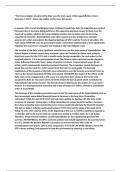Essay
“The Franco-Belgian invasion of the Ruhr was the main cause of the hyperinflation crisis in Germany in 1923”. Assess the validity of this view. (25 marks)
- Institution
- AQA
An A* exemplar essay on how the invasion of the Ruhr 1923 contributed to the hyperinflation crisis that plagued Germany.
[Show more]



